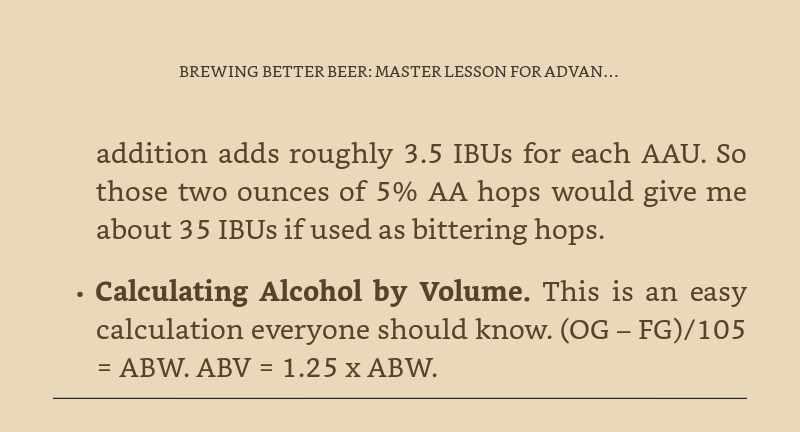strange-steve
Quantum Brewer
- Joined
- Apr 8, 2014
- Messages
- 6,027
- Reaction score
- 5,805
I'm pretty sure this formula for calculating ABW is wrong, it should be (OG-FG)x105 rather than divided by 105 right? Or am I being stupid again?




Turns out I've been using the equation for wine :lol:
I suppose it can't make that much difference, or Coopers wouldn't tell you to use it.














They have very similar answers. For arguments sake let's say we have an SG of 1.040 and an FG of 1.010.
With my equation that would be 30/7.36=4.07%
With the beer calc given that would be 0.03x133.62=4.008%
Not enough of a difference to bother me for home brewing purposes.
Why do the equations differ at all? The only thing I can think of is that different yeasts are used for wine and beer.
Why donââ¬â¢t calculators all agree?
1. The relationship between the change in gravity, and the change in ABV is not linear. All these equations are approximations.
2. Some calculators round internally as they go. The Brewerââ¬â¢s Friend calculator rounds only at the very end, which means significant digits are kept along the way (making it more true to the equation).
3. Other online calculators should be close to one of the two equations reported by the Brewerââ¬â¢s Friend ABV Calculator. If not, they are doing their own thing which warrants inquiry.
Going beyond the scope of the initial post I think I have got my head around why no calculation based on SG are perfect, please let me know if you think i'm on the right track.
The OG reading is basically water SG 1 plus various sugars (I don't think anything else contributes enough to be measurable) making it over 1. The FG is measuring the same water with the sugar having been eaten by the yeast and replaced with alcohol SG 0.789 and CO2 which leaves. So the difference in OG and FG basically can be considered a measurement of the sugar used. The reason this can never give you a perfect reading is not 100% of the lost sugar produces alcohol as some goes on yeast reproduction or creating esters or phenols and this amount is not consistent. HMRC seems to take the approach that the higher the ABV the less sugar is used in non alcohol production but obviously thats not going to be perfect and I imagine pitching rates will have an impact.
Does that sound right?
If you want to see HMRCs formula see https://www.gov.uk/government/publi...notice-226-beer-duty--2#distillation-analysis and scroll right down to 30.2 & 30.3
@Iainm do undissolved particles have an effect on the hydrometer reading?
Edit to add: I've read people saying yes and others saying no, but never heard a definitive answer.
Yeah I think so. After all, hydrometers are based on Archimedes principle. I know it breaks down in some cases, like gels, emulsions and custard, but for gunk-in-wort I've always assumed it's just fluid that hasn't been separated by gravity yet. I could be wrong.
Ok so if the particles are in suspension, the weight of the fluid displaced by the hydrometer will be greater (assuming they are more dense) and therefore increase the upward force acting on the hydrometer, giving a higher reading. However if the particles drop out of suspension to the bottom of the trial jar you should get a truer reading. Am I getting that right?
Enter your email address to join: